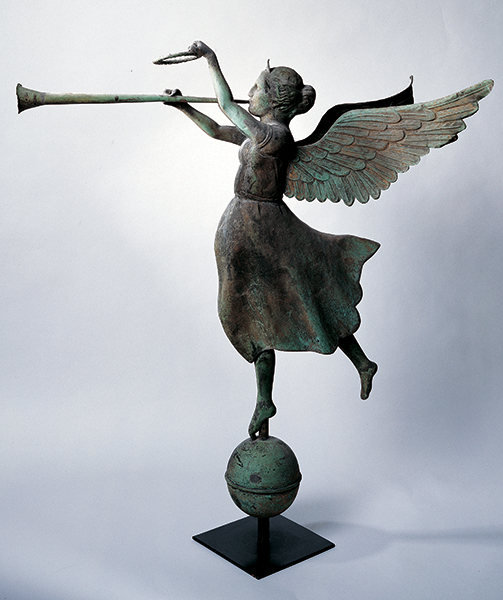Exploring the Deep and Widespread Roots Of Folk Art in NYC
 Fame Weathervane; New York City; c. 1890; copper and
Fame Weathervane; New York City; c. 1890; copper and zinc with gold leaf; 39 x 35 ¾ x 23 ½ in.; collection of
American Folk Art Museum, New York, gift of Ralph
Esmerian, 2005.8.62. Photo by Gavin Ashworth.
The American Folk Art Museum recently unveiled Made in New York City: The Business of Folk Art featuring more than 100 works by 18th, 19th, and early 20th-century self-taught artists highlighting the history of New York City as a financial and commercial capital.
On view through July 28, the exhibition showcases several copper, and bronze works of art, including the Fame Weathervane, by J.L. Mott Iron Works (1828-1903) using paint and gold leaf on copper and zinc. Though listed as a grocer in the New York City directory from 1824 to 1834, Jordan Lawrence Mott changed his profession to “stoves” and invented the original cooking stove that burned hard coal (anthracite.) He first made the stoves at his store on Water St. in Manhattan, but moved to a large piece of land at the Manor of Morrisania in the South Bronx, where he expanded into decorative iron work and weathervanes. An entire village, still known as Mott Haven, arose around his work.
The exhibition is curated by Elizabeth V. Warren, independent curator and author, and Stacy C. Hollander, deputy director for curatorial affairs and chief curator of the American Folk Art Museum.
“The exhibition Made in New York City: The Business of Folk Art could not be more timely, as it is presented when the Museum is celebrating the thirtieth anniversary of being in the center of New York’s cultural life at Lincoln Square,” says Jason T. Busch, director of the museum. “This exhibition of remarkable, richly sourced works of traditional folk art offers visitors a deeper understanding of American history and crystallizes the importance of self-taught art in the rise of the Empire City.”
The exhibition celebrates New York City’s rich history of immigrant culture, and the artistic influences that traveled with those generations. The cities diverse range of artists originated with the skills and traditions many immigrants brought from their native countries. According to Busch, Over generations, English portrait painters, German potters, Jewish woodcarvers from Eastern Europe, and French Huguenot school teachers quickly established themselves in their new home, pursuing portrait painting, ceramics, wood carving, and stitched textiles.
“Folk art has flourished in New York City since the eighteenth century. Contrary to popular belief, it was not just a rural genre. In fact, many of the objects that have been associated with the “country” were made in the five boroughs of New York,” says Warren. “The Washburne and Fiske companies of New York, for example, manufactured many of the weathervanes that crowned barns and farmhouses throughout the country. The stoneware crocks in country stores often had their origins at Thomas Commeraw’s pottery in what is now the Lower East Side, or the MacQuoid shop on Little West 12th Street. And thousands of the carousel animals enjoyed by children across America were carved in Coney Island.”
According to Warren, from its earliest days as a Dutch colony, New York was intended to operate as a commercial center.
“The city grew from trading furs and sending the profits back to the Netherlands into a mercantile center that, by the time of the Revolutionary War, was self-sufficient enough to produce many of the objects of daily life that once had to be imported,” said Warren.
Resources:
Also in this Issue:
- Garage Sale Bronze Statue Featured on Antiques Roadshow Sells at Sotheby’s for $2.1 Million
- Exploring the Deep and Widespread Roots Of Folk Art in NYC
- The Iconic Galle Chandelier Gets a Closeup at Getty
- Evoking the Power of Nature in Bronze
- MOMA Announces 2020 Donald Judd Retrospective
